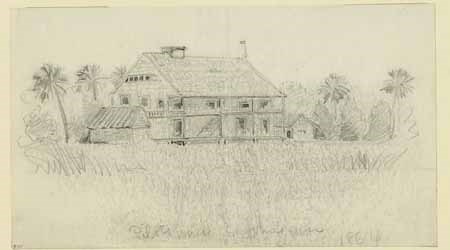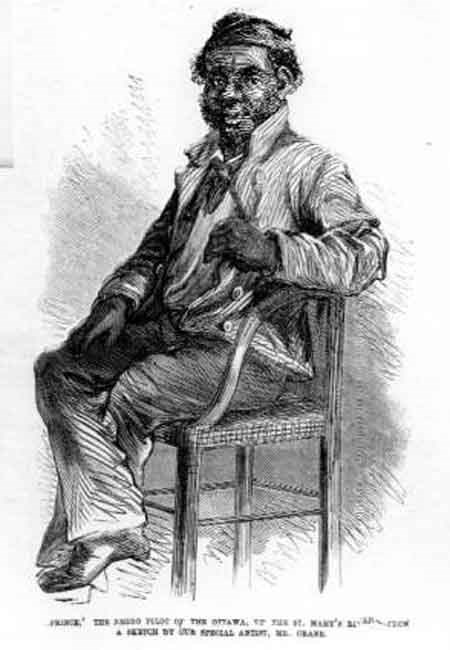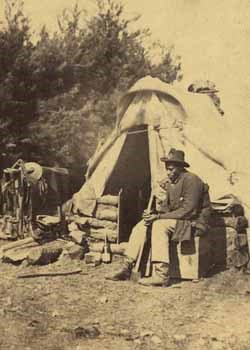
Image courtesy of the Library of Congress Before the Federal government had fully addressed the question of contraband policy in the summer of 1862, the Union Navy operating in the St. Johns had already adopted a practice of not returning fugitive slaves and establishing protected contraband communities. The Navy faced a challenge feeding the significant numbers of contraband and loyal Unionist whites they picked up, sometimes in groups numbering forty to sixty people, who could quickly deplete the ship's limited food and water supply as well as crowd the limited space onboard. In response contraband had to be sent to larger established Union bases in the South, or if that was not possible, placed ashore at improvised colonies such as Pilot Town. As early as June 1862, the Navy began delivering Unionist refugees and contraband to Pilot Town. As the colony quickly grew in size, its population included entire families and came to provide a relatively stable environment from which men could achieve employment with the military and women could earn a wage as servants or cooks. Additionally, small amounts of trade were recorded with the Union ships. An estimated two hundred twenty contraband passed through Pilot Town in the summer and fall of 1862 with a consistent population of one hundred persons by the close of the year. Although the colony could provide some of its own food in the form of corn and fish, a Union commander noted that "these colonists are all in much want of food and clothing, the latter of which it is entirely out of my power to supply."
Providing for the welfare of the colony at Pilot Town also meant ensuring its protection. Both conventional and guerilla Confederate units tried to prevent contraband from reaching the Union blockade fleet by confiscating or destroying boats belonging to Unionists along the river as well as attacking the Navy base at Mayport. To safe guard Pilot Town in areas out of range for the Union gunboats, both sailors and community members established and manned lookout posts with obstacles at key points of access to Batton Island. As further insurance against attacks, the Navy used axes to cut down the sixty-foot bridge across that connected Batton and Fort George Island and later launched a reconnaissance expedition on Fort George Island in December 1862. However, the Union protection of Pilot Town was more than just humanitarian; it had a political purpose as well. Naval commanders believed that if they could promise protection for Pilot Town, it would serve as a "nucleus for [refugees] to rally around" encouraging an "exodus" including those "who might otherwise be compelled to give their services to the Rebels." For this reason the Navy desired a permanent Union Army force be stationed at Pilot Town. However by the close of 1862, an increased Confederate presence in the area and the drain caused by Pilot Town's large population on the Navy's limited resources resulted in the colony's occupants being removed to larger military bases. Pilot Town was periodically revived as a contraband colony until the end of the war as well as serving as a small Union Army signal station between gunboats at the river mouth and Jacksonville.

Image courtesy of the State Archives of Florida, Florida Memory Because the Union commanders hailing from the North had little firsthand knowledge of the area when they arrived in early 1862, one of the most important ways contraband aided operations along the St. Johns was by providing their local knowledge. Throughout 1862, the blockading fleet actively sought out and used intelligence obtained from contraband in key actions against Confederate defenses. Some contraband even went a step further and served as guides on these undertakings, such as the contraband led Union capture of the Confederate fort at St. Johns Bluff in October 1862. Intelligence recorded as specifically coming out of Pilot Town included the movements of Confederate troops and the locations of lumber mills and salt works. Another way contraband eased Union deficiencies in local knowledge was by serving as pilots aboard the Union gunboats, a service regarded as "beyond all price" by regional commander, Rear Admiral Samuel Dupont. The exact number of black pilots in the Southern Blockading Fleet is unknown, with only thirteen black pilots being specifically mentioned by name in Union Naval records. Likely more fugitive slaves served in this capacity but remained unmentioned or were simply recorded, as one gunboat commander wrote, "retaining and enlisting one [contraband] for the present on account of his local knowledge" during a patrol to Black Creek off the St. Johns. Pilot Town's reopening during the summer of 1862 included the goal of providing protection for "former bar pilots who were willing to return with their families" who had been "driven away from here by threats, and are now living in great distress and temporary shanties in the woods." These threats were very real promises of reprisal by Confederates, as evidenced by the May 1862 hanging of a captured black Union pilot.
The Navy also readily sought to enlist contraband to replenish the shorthanded crews of the Union gunboats and as a way to relieve the burden of simply giving away the blockading fleet's provisions to contraband by getting much needed service in return. Unlike the Union Army, which prevented black enlistment before 1863, the Navy had authorized the recruitment of blacks for service in September 1861. It is estimated the blockading fleets enlisted eleven thousand free blacks and contraband over the course of the war. This recruitment largely took place in occupied Southern cities but also occurred aboard blockading vessels and in contraband colonies such as Pilot Town. The Union report of the population at Pilot Town in December 1862 recorded "most at the colony are either old men or disqualified by some imperfection." The lack of able-bodied young black men at Pilot Town seemingly indicates their widespread enlistment in the Navy. Prior to the 1863 Emancipation Proclamation, enlistment by contraband did not technically make them free. However the steady income, a percentage of which could be allotted to their families, was relied on heavily to support contraband families living in camps such as Pilot Town. The beginning of 1863 marked the expiration of many Union enlistments along the St. Johns, and together with the Emancipation Proclamation, caused the Navy to now also actively encourage slaves to flee bondage in the South in order to gain more recruits.

Image courtesy of the Library of Congress |
Last updated: July 17, 2020
